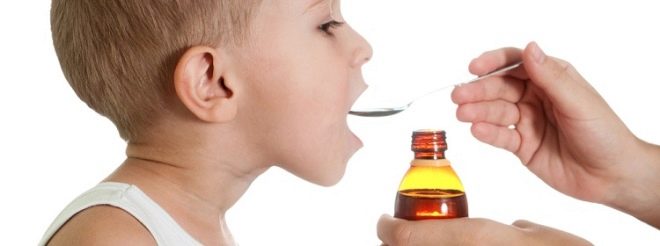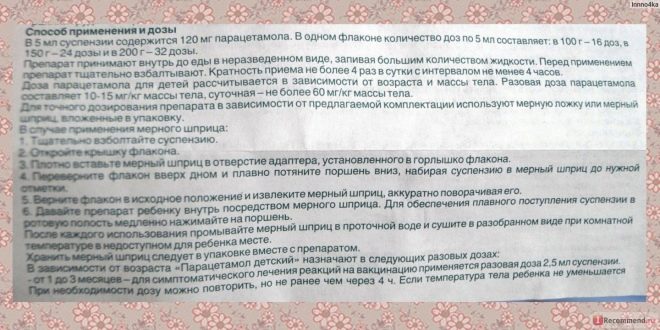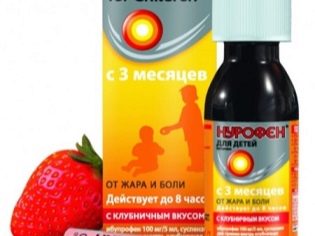Paracetamol for a child of 4 years
Paracetamol is called the safest medicine for children among all drugs with antipyretic effect. Therefore, it can be used in the form of a suspension or suppository from 3 months of age. Such a drug is often bought for a home first-aid kit and is in demand among preschoolers, because they are sick with ARVI and childhood infections quite often.
In what dose Paracetamol is used in children 4 years old, how often this medicine can be given, and whether it can be a danger to the child’s body, will be discussed in this article.
How does it work and when is it appointed?
Paracetamol is an antipyretic and analgesic drug, but the anti-inflammatory effect in both suppositories and suspensions is practically absent. Once absorbed into the bloodstream after absorption in the digestive tract, Paracetamol is transferred to the brain tissue, where it acts on enzymes "Cyclooxygenase". Blocking them affects the centers of regulation of temperature and pain, so the result of taking the medicine will be the normalization of elevated temperature and the elimination of pain.
More often Paracetamol is prescribed for children with fever., because such a medicine is good for knocking down the temperature due to various reasons (infection, vaccination, overheating and others).
The drug can also be given to a 4-year-old child with pain, for example, if the baby has pain. throat, eye or injured leg. Paracetamol effectively eliminates such unpleasant sensations, if the pain is unexpressed or of moderate intensity.
Instructions for use
The suspension is metered with a spoon or syringe, which is in the box with the bottle. Such a remedy is recommended to give 1-2 hours after meals, but at very high temperatures, the patient's diet is not taken into account. It is not necessary to dilute the medicine with water - it is better to let the child swallow the suspension from the spoon or pour the contents of the syringe into his mouth, and then suggest drinking the medicine with plain water. After taking the suspension, the measuring spoon or syringe must be rinsed and left to dry, and then put in a bottle, which is important to keep out of reach of children.
Suppositories are most often used at night., since the beginning of their action is very long (the effect begins to manifest itself in 1.5-2 hours). To prevent this form of paracetamol from provoking bowel movements, it is worth inserting a candle either after a natural bowel movement or after an enema. During the introduction of the suppository, the child should lie down. If necessary, the candle can be divided into parts.
Dosage
The determination of the effective and tolerable dosage of Paracetamol is not affected by the child’s age, but by its body weight. Finding out how much the baby weighs in kilograms, this number is multiplied by 10-15 (when using candles - by 20-25). The result is the amount of medicine in milligrams, which is needed at one time.
For example, a four-year-old child weighs 16 kg, then a single dose for such a patient will be 160-240 mg. This dosage baby can get from 7-10 ml of suspension. To facilitate the calculation of the dose, in the annotations to the liquid Paracetamol there is a plate indicating the average doses for patients of a certain weight. According to this table, if the weight of a 4-year-old baby is less than 16 kg, he is given 5 ml of suspension per dose, and if the child weighs from 16 to 32 kg, then the single dose for him will be 10 ml.
The maximum dose of the drug per day is also determined by weight, since in childhood it is impossible to give more than 60 mg of Paracetamol per kilogram of body weight of a child.
So, for our patient with a weight of 16 kg daily dose is 960 mg. Her child can get from 40 ml of suspension. This means that when used four times, such a baby should not be given more than 10 ml of the drug. If the drug is given three times a day, then a single dose can be increased to 13 ml.
Cautions
It is important for parents to understand that Paracetamol is a symptomatic remedy, that is, this medication only affects symptoms such as fever or pain, but does not eliminate the cause of the disease. Therefore, parents should know the following:
- Paracetamol should not be given to children with gastrointestinal ulcer, glucose-6-phosphate dehydrogenase deficiency, intolerance to any ingredient of the medication and some other pathologies. To make sure that the child does not have the disease, included in contraindications to receiving Paracetamol, you should first show the baby to the doctor.
- When treating Paracetamol, side effects may occur, such as an allergic reaction in the form of a rash, nausea, or bronchospasm. If any negative symptom occurs, use should immediately stop and then consult a doctor to select another therapy.
- Taking Paracetamol for too long can affect blood formation, liver function and other organs of the child. And therefore, it is impossible to give the medication for more than three days at elevated temperatures without medical supervision. If Paracetamol is prescribed for pain, the permissible duration of use is 5 days.
- The drug is prescribed to children from 1 to 4 times a day, but the next admission should be no earlier than four hours after the previous dose. If the temperature does not decrease, it is recommended to call the doctor to determine the cause and prescribe another treatment.
- If a child accidentally finds a suspension and, because of its sweet strawberry or orange flavor, drinks the drug, you should immediately show the baby to the doctor. The first symptoms of an overdose are usually associated with irritation of the gastrointestinal tract and are nausea, spasmodic pain, diarrhea, and other signs of poisoning. However, an overdose of the drug can damage the child’s liver, and the symptoms of such a lesion only appear after 12 hours or later. So, even with good health a child with an overdose necessarily requires medical assistance.
- It is not necessary to combine Paracetamol and other drugs on temperature without a prescription from the doctor, even if the candle or suspension did not work. If the child is already drinking any medications, you need to check their compatibility before using Paracetamol.
Analogs
Instead of Paracetamol, a child of 4 years old can be given any other drug with the same effect as on the basis of paracetamol (Panadol Baby, Calpol, Efferalgan)so and containing Ibuprofen (Nurofen for children, ibuprofen). Such drugs are permitted to preschool children and effectively fight both high fever and painful sensations.
In some cases, the doctor replaces Paracetamol with other drugs with a similar effect (Voltaren, Nise, Next, Analgin and others), but they are used less often in childhood, as they can cause dangerous side reactions.


















